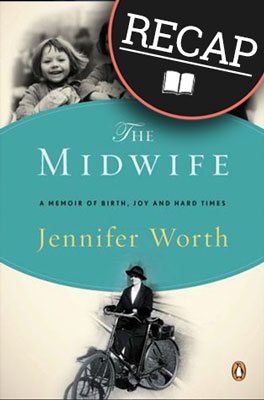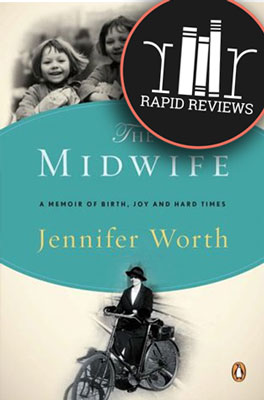Read a full summary of The Midwife Trilogy—on which the Call the Midwife television show is based—by Jennifer Worth, right here! This page is full of spoilers, so beware. If you are wondering what happened in The Midwife Trilogy, then you are in the right place!
Special thanks to Sarina Byron, a new BSR contributor who wrote this great recap! Sarina is a British Author and Contributing Writer living in California. Sarina enjoys bringing forth a different perspective and encouraging a different way of thinking through her writing. Visit her blog to read her reviews, and check the end of the review for a link to her Instagram.
Author
Jennifer Worth
Ratings
4.9 stars on Amazon
4.43 stars on Goodreads
Add The Midwife Trilogy on Goodreads.
***** Everything below is a SPOILER *****
What happened in The Midwife Trilogy?
Book 1: Call the Midwife
Starting with Call the Midwife, one is introduced to Jenny Lee and the lovely sisters of Nonnatus House, the name being a pseudonym based on the patron saint of midwives, obstetricians, pregnant women, childbirth, and new-born babies. Having been delivered by Caesarean section himself in 1204, the name “Nonnatus” means “not born” in Latin and remains the pseudonym used through all the books and the television series. Call the Midwife begins by providing a glimpse into life in the East End, the stark contrasts that were lived in close quarters, such as high employment but low wages, children playing in bombsites adding innocence to the macabre, high crime rates but immense respect for anyone in a uniform, especially a nurse.
Being a book focused on midwifery matters, the early chapters are dedicated to the discussion of several conditions such as eclampsia, rickets, and the antenatal clinic. These chapters also discuss early attitudes to midwifery, especially to that of training midwives, which was considered an absurdity in 1870. Midwifery work was done by untrained women called “handywomen” who had no formal training, and it wasn’t until 1902 that the first midwives act was passed by Parliament. Jenny also sheds illuminating insights into the identification and treatment of conditions mentioned earlier in the paragraph.
Jenny dedicates many chapters to take the reader through the lives of several interesting characters whose stories present as untangled parallels but are tied together beautifully by the author. Starting with Chummy, who is of aristocratic descent, her chosen vocation having caused much distress amongst her family. There’s an entire fascinating chapter on Chummy learning to ride a bike and the boy Jack who dedicates his days to teaching her to ride and chaperoning her to appointments. Jack’s protective instincts served him well as he went on to be a personal bodyguard of Princess Diana.
There’s the story of Len and Conchita Warren, who have 25 children. The book describes two of her deliveries, the second of which is that of a pre-mature baby. Then there’s the life of the “girls of Cable street night cafes,” one of whose life Jenny gets an intimate look into. That girl is Marie, who Jenny befriended through the oddest circumstances and through whom she learns of Zakir, who had turned her into a lady of the trade. Five chapters in the book take one through Mary’s journey from Ireland all the way to Cable Street in Poplar and how she flees Cable Street for a chance of a decent life but ends up in prison. Mary’s story ties closely into the story of Father Joe Williamson, who dedicated his life to improving the lives of those in Poplar and set up the Wellclose Trust, operational until today. Mrs. Jenkins’ story of how she ends up losing to one circumstance after the other and ends up in the workhouse spans over three chapters. An intimate account into the declining quality of her life is a close glimpse of the bleak life without social welfare and in a workhouse.
Mixed descent babies—both accepted and unaccepted—enjoy more than a mention in this book. The three stories of illegitimate babies cover the spectrum of emotions in these circumstances: Ted, who lovingly accepts the baby; Bella, who expected her baby to give away her infidelity and carefully planned for her husband to be out and whose mother was determined to “take care” of the new-born; and Doris and Cyril, whose very obviously illegitimate baby was whisked away in the night by the Rector. Jenny confesses her friendship and fascination for Sister Monica Joan at many points in this book, especially with a chapter on when Sister Monica Joan put into place an uppity journalist that tried being smart with Sister Bernadette.
Notable Quote: “What the eye does not see the heart does not grieve.” – Jennifer Worth
Book 2: Shadows of the Workhouse
Shadows of the Workhouse (Book 2) may yet be the most heart-breaking book of all times. As opposed to Call the Midwife (Book 1), this is clearly divided into three sections.
The first section walks through the stories of children who grew up in the Poplar workhouse and who were intimately known to each other. The first story is that of Jane, who having overheard that she was the child of a high-born gentleman, infused her days with joy from that knowledge. Her story may be the most painful after Mrs. Jenkins in Call the Midwife. In graphic detail, we follow the story of how she falls into trouble with the Master of the Workhouse by hugging Sir Ian Astor-Smaleigh and calling him father. This act wins her intense reprimand in the form of a savage beating and months of being shamed, eventually breaking her creative and buoyant spirit.
Followed by a detailed account of Frank and Peggy, this book shows another undesirable effect of the workhouse system. Having separated brother and sister as they outgrew the workhouse nursery, the sibling bond was severed only to be replaced by a most unnatural one. Through good fortune, Frank leaves the workhouse as a Costermonger’s apprentice and soon after goes independent. He then goes back to the workhouse to get his sister out after working hard, saving every penny, acquiring suitable lodgings, and demonstrating his competence to the Board of Guardians of the Workhouse. Thereon, no one comes between Frank and Peggy, and they remain both siblings and lovers to each other through life.
These distressing accounts are followed by a detailed account of the trial of Sister Monica Joan. Six chapters that follow what should be an upsetting event are made extremely entertaining by Sister Monica Joan’s condescending attitude towards the law and lawmakers. Jenny relates how Sister Monica Joan enjoyed pinching small items, earning the ire of the Costermongers and the Police. When high value items were found in her possession, it was assumed that she had stolen them, leading to the trial. The most fascinating part of the trial was the psychiatrists who were asked to assess Sister Monica Joan’s mental condition, of which the qualified psychiatrist declared her perfectly sound of mind. The other was a self-taught doctor Sir Lorimer, who was popular amongst high-society ladies. Post his assessment of Sister Monica Joan, he declared her sharp but not sound of mind. The entire ordeal ended with Mother Jesu Emmanuel testifying that the jewels were Sister Monica Joan’s inheritance from her late mother, and the Costermongers and Jewellers have to eat humble pie in their erroneous allegations.
This book delves into a detailed history of the Workhouse system all the way from 1601, leading into the story of Guardsman Collete and why he didn’t survive being moved from his apartment into a Care Hospital, which was a former Workhouse. Guardsman Collette grew up in abject poverty and joined the Army for the shilling a day pay which would allow him to support his mother in Poplar. He gets recruited over a breakfast in the West End and is enrolled so fast that he comes back to Poplar in full uniform and leaves for his first posting that very night. The story follows his life from the Boer Wars to the two Great Wars, lasting until he is extremely old and lonely. Having lost his wife, twin sons, and daughter to war service, he is living amongst strangers in Poplar when Jenny meets him. She is tasked with cleaning his infected leg wounds, and the two strike up quite a friendship. Even when he is moved to St. Mark’s, a considerable distance from Poplar, Jenny makes an effort to go see him as often as possible. His enhanced loneliness, even amongst a ward full of men his age, gives her much pain, and she tries to make the time as bearable as possible for him. The end comes in the guise of a leg amputation surgery and war hysteria.
Notable Quote: “Pain is a mystery that we cannot fathom, because there is no measure.” – Jennifer Worth
Book 3: Farewell to the East End
Reluctantly, we head to the last book in The Midwife Trilogy: Farewell to the East End. Much like life, this starts with a riddle and ends in adieu. Novice Ruth and the Angels loom large at the beginning with a graphic description of a sailor’s sweetheart lodging in a decrepit building, delivering triplets in the dead of the night. There was no one with her except Novice Ruth until the babies came, and we never really find out whether the sailor who lured her away from sunny Ireland ever showed up.
We follow the distressing journey of Cynthia through the sudden death of the Kelly baby on account of atelectasis and her being a carrier of staphylococcus aureus and passing it on to the babies. The former brings up an uncomfortable discussion on lost babies: those lost to suffocation, those given away on account of disability, illegitimacy, etc., or worse yet, those sold. Many a reason were discussed in the book along with statistics from Charles Booth, who was the first social statistician. All the lost babies, whether alive or dead, were classified “still-born.”
This book also allows a rare glimpse into Sister Monica Joan’s childhood, and we learn why she chose to take the veil. She had seen her mother and aunt both suffer immensely and lose control over their lives simply for being wives of powerful men in prominent positions in society. Whilst recalling her childhood, she speaks of her maid Nancy who had been sent to her house following a surgical rape by a local doctor and cop under the Contagious Diseases Act of 1864, which impacted working class women disproportionately. Josephine Butler, who was instrumental in having this Act repealed in 1883, looms large in this book and serves as an inspiration to Sister Monica Joan’s courageous life.
We then move on to the story of joint-at-the-hip twins Meg and Mave, who turn up to every clinic with a new book from the 16th and 17th Century to challenge the midwives. Names not spoken in over a hundred years are quoted as wisdom to rely on: Nicholas Culpepper (1651), Jane Sharp (1671), and Dr. Jacob Renff (1534) provided answers acceptable to the twins much more than those of the midwives. Following closely on the heels of their story is the story of the Mr. and Mrs. Lacy, whose son comes all the way from the United States to visit them with his fiancé only to reject them.
The next story of the pub Master’s Arms, its Publican Mr. Masterton and his daughter Ms Masterton follows next, demonstrating how family remains family no matter how many rifts they experience. After six years of staying away from the pub where she had lost all her siblings, Julia Masterton returns to find her father in failing health and stays on never to go away. She looks after him until he peacefully passes away and then runs the pub through thick and thin, including losing her own child to tuberculosis, only to discover she had been a carrier and probably was the one who passed it on to her own child.
Thus follows the story of tuberculosis, or the Great White plague of Europe, as it came to be called. The book goes into great detail about the many cures, climates, drugs, and treatments tried for the fatal disease. Known as “wasting fever” and “consumption,” tuberculosis claimed scores of lives across Europe. The story of tuberculosis ends in the book with the discovery of the vaccine by Dr. Robert Koch and its successful administration in the 1950s.
Another tortured soul in this book was Mrs. Harding, who, like the other women of Poplar, had child after child, all of which thrived in terribly unfavourable conditions, including the last one she desperately tried to have aborted through a back-street abortionist. Mercifully, she survives the ordeal and all we gained knowledge of the distressing options available to women before the advent of women-controlled contraception. Chummy reigns supreme in the skillful manner with which she delivered a baby in a tough presenting condition on a cargo ship. The entire ordeal, although fleeting, was enough for the Captain to provide better for his daughter.
The book concludes by providing a summary of the life of the many characters we meet through the three books. Amazingly, the last days of Sister Monica Joan are lived as gregariously as her entire life, the last episode being filled with extravagant taxi rides to Richmond and the West End. This last book is dedicated to Cynthia, remembering her tumultuous but well-lived life. Cynthia took the monastic vows only to leave the Church and join again and leave again. She finally found happiness in a partner with whom she travelled across Europe and to a mission in Peru. Her oft-returning depression tormented her continuously, but she soldiered on and made her life count. Novice Ruth suffered the dark night of the soul and abandoned a life within the Church. Sister Bernadette, on account of her disapproval of women being ordained into priesthood in the Anglican Church, left to take up vows with a Catholic Church. Sister Julienne died in 1991 of a brain tumour and remained in touch with Jenny all her life. Meanwhile, Sister Evangelina was the only one to be buried in Poplar amongst those she served.
Bonus Recap 1 (supplementary book): In the Midst of Life
Possibly the most medical book after Call the Midwife (Book 1), this book dives right in with a description of Jenny’s grandfather’s natural and peaceful death. The point of describing his death was to show how doctors, back when Jennifer was growing up, accepted that people die of old age. In stark contrast the next story is that of Mrs. Ratski, a tough Latvian woman who lost her husband and all sons except one when they were drafted into the German army. She walked all the way across Europe to the UK to see her last living son Slavek and his family. Unfortunately, she suffered acute intestinal obstruction whilst in the UK, and there began an uphill battle to save her life by the extremely skilled medical staff. They saved her life but the family was destroyed. Mrs. Ratski suffered trauma at the hospital as she could not understand what the doctors were saying or doing and fell prey to a delusion that she was in a concentration camp. The treatment left her incapacitated, and Slavek’s wife left him as she could not bear to look after this old lady she had no bond with. Slavek fell in with the drink and wasted away, losing his job and then his house. Unfortunately, Mrs. Ratski was alive for all of this and had to be taken in by a nursing home, where she finally mercifully died. But she was amongst strangers and had lost the will that had allowed her to walk across Europe at 80+ years old.
Jennifer writes of two remarkable women who worked tirelessly through their lives to restore dignity to the dying: Dr. Elisabeth Kubler-Ross and Dame Cicely Saunders. Of the changing attitude towards dying, Jennifer writes, “Not so long ago, old age was seen as the natural winding down of life. Now our waning years are viewed as a series of illnesses requiring medical intervention.” In her days as a nurse in New York, Elisabeth noted that doctors appeared to be embarrassed to admit a patient was dying. This head-in-the-sand attitude clashed with her upbringing in Switzerland, where the dying were treated with love and compassion.
On moving to Colorado (USA), she began a job as a liaison between psychiatry and the general medicine ward. This department was headed by a professor who Elisabeth connected with on the effects of non-communication and rejection on terminally ill patients. This professor gave her the opportunity to lecture his classes, during which she allowed a terminally ill patient to speak with the medical students, forcing them to look at the face and death and re-think their attitude. This began her life as a successful lecturer; so widespread was her fame that Macmillan Publishing asked her to write a book on the topic. The result, On Death and Dying, published 1969, was written in two months and to this day is considered a master text on the subject.
Similarly but even more impactful was Dame Cicely Saunders, who recognised the lack in physician care for the dying and set about changing that. Inspired by this need, she trained as a doctor and devoted her entire career to the care of the dying. Her life’s work resulted in a hospice dedicated to the care of the dying, St. Christopher’s Hospice in Kent.
Jenny described her time as a ward sister in Marie Curie hospital, which sees many cancer patients cared for in their declining years: Mr. Anderson, the determined businessman who set up his office in a broom closet; Mrs. Merton, who the nurses thought was alone but was surrounded by the love of the family where she had been nanny for many years; and Mrs Cunningham, who had been a world traveler and shared the details of her many exploits generously with Jenny. Mrs. Cunningham had been a lifelong member of the British Humane Society, and upon learning that she had cancer, she demanded euthanasia. Upon being denied, she rapidly deteriorated and isolated herself from her children and staff, thus dying all alone after spending many days in abject sorrow.
Through the story of Dr. Conrad Hyem, who was well-known to Jennifer, she approaches the topic of resuscitation. She describes in detail the process and impact of open-heart resuscitation and cardio-pulmonary resuscitation. The former was administered to her dear friend, who wished not to be resuscitated and was never whole again but lived five weeks after the procedure in a vegetative state. Jennifer shares the resuscitation performed by paramedics responding to a 999 call and demonstrates how the process is for the already dead is deeply undignified.
Overall in her singular way of sharing stories to share or debate her views Jennifer tackles many difficult topics and decisions doctors and families are forced to make in the face of grave illness or fast approaching death.
Notable Quote: “It is interesting to speculate on how life turns out for each of us, and how chance plays its part.” – Jennifer Worth
Bonus Recap 2 (supplementary book): Letters to the Midwife
The name conjures up images of the colleagues at Nonnatus writing to Jenny Lee after she left, but this book is so much better. It is a number of the letters Jenny received after people read her book trilogy and the stand-alone In the Midst of Life. The book begins with short impactful essays by her daughter Suzanne Hart, husband Philip Worth, other daughter Juliette Walton, and grandchildren Ellie, Lydia, and Dan.
These essays speak of the remarkable woman that Jennifer was and the principles by which she lived. They speak of how she met her husband Philip whilst nursing his sister in Queen Mary Maternity Hospital in Hampstead. They summarise Jennifer’s departure from Nursing in 1973 on account of her disappointment in the bureaucratisation of the National Health Service (NHS) and the adoption of the practise of resuscitation, both themes she explores in In the Midst of Life. They speak of her urge for constantly striving for intellectual and creative endeavours, leading her to study music after her departure from nursing and resulting in her teaching music for many years. Her final career was that of an author, which ended with her peacefully passing away surrounded by her family.
Of the many letters she received after the publication of her books, a few notable ones are summarised here. Syd Bailey shared her experience of being the offspring of the master and mistress of a workhouse, who were unlike the persona of a cruel master and mistress that dominates popular recall. A number of photos shared by Syd Bailey are included in the final book, one of which even includes Father Joe Williamson from the first book.
Ann Croft writes in identifying the little girls on the cover of Call the Midwife as one being either her or her twin Ruth, with the two other girls being Sandra Silk and Janet Silk. Marjorie Lambert wrote in describing her experience as a midwife, which included even delivering on a barge! Anne Rossiter shares her experience of nursing in America with the Frontier Nursing Service, which was started by Mary Breckenridge in 1925 to fill the gap of no trained midwives in America. Ruth Manley writes of two girls she came across in the East End who were victims of extreme neglect and were eating food left out for the birds. Brenda Warwick remembers a husband who refused to leave the bed when his wife was giving birth. Sadie Hollan recalls her time as a midwife in South-East London, specifically one night when on her way home when she came across not one person but 15 foxes. Rosemary Fittock was the daughter of the cook at Nonnatus before the famous Mrs. B in the Midwife books and recalls how her mother and a certain Mrs. Wade also cleaned the chapel floor.
Apart from the essays by her family, this book also chronicles Jennifer’s time as an au pair in Paris, which preceded her time in the East End of London, and excerpts on faith from her personal diaries. Jennifer’s time in Paris is an exciting insight into her view on French society, which she found to be extremely protective of family life, tolerating no public arrangements outside wedlock. She provides detailed descriptions of the three families with which she lives and the starkly contrasting ways of life they embodied. The book ends with letters received after her passing, which were responded to by her daughter Suzanne.
Notable Quote: “Let me keep a vision of perfection ahead of me.” – Jennifer Worth’s personal diary
There you go! That’s what happened in The Midwife Trilogy. We hope you enjoyed this The Midwife Trilogy summary with spoilers.
Ready to read The Midwife Trilogy? Click to buy and help us pay for hosting!

What now?
Don’t forget to check out Sarina’s blog, and you can follow her on Instagram!
Follow Book Series Recaps on Instagram and Twitter.
Friend us on Goodreads: Sara and Stacy.
Check out awesome art, quotes and more on Pinterest.
Oh and share this with your friends who might like to read a recap of The Midwife Trilogy.




















